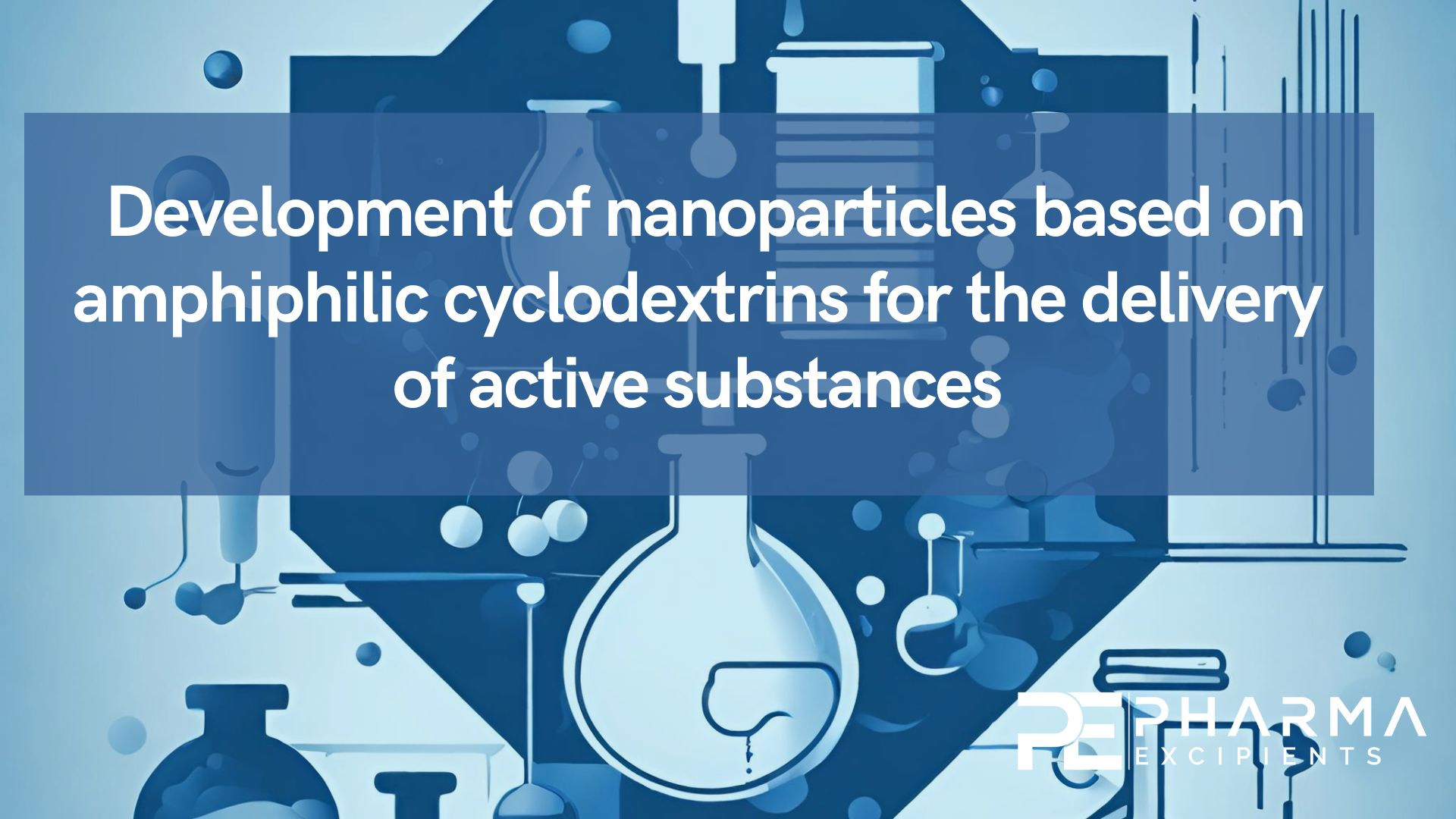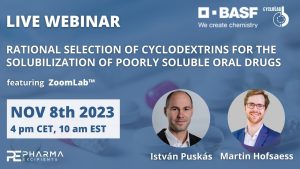Development of nanoparticles based on amphiphilic cyclodextrins for the delivery of active substances

Abstract
Amphiphilic cyclodextrin derivatives (ACD) are useful starting materials for nanomedicines; however, their synthesis using enzymatic catalysis is unsatisfactory. This work focuses on a robust alternative pathway using mineral base catalysis to transesterify β-cyclodextrin with long-chain vinyl esters, yielding ACD with modular and controlled hydrocarbon chain grafting. ACDs with a wide range of degrees of substitution (DS) were reliably synthesized, as indicated by extensive physicochemical characterization, including MALDI-TOF mass spectrometry. The influence of various factors, including the type of catalyst and the length of the hydrocarbon moiety of the vinyl ester, was studied in detail. ACDs were assessed for their ability to form colloidal suspensions by nanoprecipitation, with or without PEGylated phospholipid. Small-angle X-ray scattering and cryo-electron microscopy revealed the formation of nanoparticles with distinct ultrastructures depending on the DS: an onion-like structure for low and very high DS, and reversed hexagonal organization for DS between 4.5 and 6.1. We confirmed the furtivity of the PEGylated versions of the nanoparticles through complement activation experiments and that they were well tolerated in-vivo on a zebrafish larvae model after intravenous injection. Furthermore, a biodistribution experiment showed that the nanoparticles left the bloodstream within 10 hours after injection and were phagocytosed by macrophages.
Introduction
Nanotechnology has brought about a revolution in the field of medicine with innovative methods for both disease diagnosis and treatment, particularly through the use of nanocarriers (Duncan and Gaspar, 2011, Khan, 2022, Kher and Kumar, 2022). Nanocarriers or nanoparticles are nanoscale structures that are designed to deliver various substances, such as drugs, genes, or imaging agents, to specific targets within the body (Couvreur and Vauthier, 2006).
The introduction of cage molecules (cyclodextrins, calixarenes, etc.) as building blocks for nanoparticle design has attracted significant attention in drug delivery purposes (Jiménez Blanco et al., 2017). The internal cavities of these supramolecules not only enable the modulation of the toxicity and bioavailability of encapsulated active substances but also contribute to enhancing their solubility. Cyclodextrins (CDs), for instance, are known for their capacity to form inclusion complexes with hydrophobic drugs, as documented in several studies (Zagami et al., 2023, Treccani et al., 2022, Challa et al., 2005, Davis and Brewster, 2004, Irie and Uekama, 1997, Komiyama, 2023, Loftsson and Brewster, 2012).
The most frequently used native CDs are cyclic oligosaccharides composed of 6, 7, or 8 glucose units, known as α-CD, β -CD and γ-CD, respectively. They are produced by enzymatic degradation of starch by glucosyltransferase. Although CDs are generally considered to be biocompatible (Davis and Brewster, 2004), their degree of toxicity varies. Cyclodextrins are typically non-toxic when used orally or topically. However, parenterally, some CDs, such as α -CD and β -CD, can exhibit cytotoxicity and nephrotoxicity due to solubilization and extraction of vital cellular components (Irie and Uekama, 1997). However, these side-effects can be significantly reduced by modifications producing derivatives such as alkyl ester- β -CD, hydroxypropyl- β -CD and sulfobutylether- β -CD; which also provide interesting new properties such as improved inclusion complexation, controlled drug delivery capabilities, and enhanced safety (Debouzy et al., 2008, Memisoglu-Bilensoy et al., 2005, Stella and He, 2008, Zhang and Ma, 2013).
CDs possess a hydrophilic outer surface and a hydrophobic inner cavity but their hydrophilic nature limits their efficacy in delivering drugs to hydrophobic environments such as lipid bilayer membranes (Wang et al., 2019). To overcome this limitation, it is possible to take advantage of the ability of amphiphilic cyclodextrins to self-organize spontaneously into nanoparticles (McNicholas et al., 2007, Quaglia et al., 2009). These amphiphilic cyclodextrin nanoparticles (ACD-NPs) possess both hydrophobic and hydrophilic properties and therefore offer several advantages over conventional CDs and other nanoparticle systems. Firstly, their expanded hydrophobic compartments allow them to encapsulate larger hydrophobic molecules and in greater amounts, resulting in improved drug loading and increased drug bioavailability (De Gaetano et al., 2023). Secondly, ACD-NPs have the capability to encapsulate hydrophilic drugs within their water-based cores (Lemos-Senna et al., 1998, Skiba et al., 1996), and within the cyclodextrin’s cavity itself (Raffaini and Ganazzoli, 2007).Thirdly, the surface modification of ACD-NPs can be tailored to enhance their stability, circulation time, and targeting ability (Bandi et al., 2020, Perret et al., 2018). ACD-NPs have already been tested for the delivery of hormones, antibiotics, anti-inflammatory drugs, and antifungal agents (Skiba et al., 1995, Uekama et al., 1998).
Traditional methods for chemically modifying cyclodextrins involve intricate multi-step syntheses using protecting groups like t-butyldimethylsilyl ether, often resulting in low overall yields (Benkovics et al., 2021). Additionally, these processes present challenges due to the presence of three distinct types of alcohol on the CD, each having very specific reactivity. Several strategies have been developed to selectively modify either the primary face (Memişoğlu et al., 2002) or the secondary face (Lesieur et al., 2000), where the secondary face refers to the larger circle of the truncated cone, which is composed of 14 secondary alcohols. In contrast, the opposing primary face is composed of 7 primary alcohols. A simpler chemical approach to produce ACDs in a single step is through direct esterification or acylation of native cyclodextrins, allowing substitutions to occur freely.
Completely per-substituted cyclodextrins, whether modified on one or both sides, known as single isomers, have been observed to form NPs that exhibit noticeable differences in stability based on the nature of the substituents. CDs carrying hydrophobic chains on one side and other substituents on the other —such as halogens, PEGs, or sugars— tend to generate stable (Mendez-Ardoy et al., 2012), spontaneous (Kauscher et al., 2013, McNicholas et al., 2007, Mohan Nalluri et al., 2011, Samanta et al., 2012, Voskuhl et al., 2010), and even organized NPs (Falvey et al., 2005, Mohan Nalluri et al., 2011, Villari et al., 2013). However, CDs solely substituted with hydrophobic components, such as per-acylated β-CD with fatty acids on the secondary face and lacking any other substitutions on the primary face, tend to exhibit unstable self-arrangement (Geze et al., 2002). Therefore, when preparing NPs from CDs esterified with fatty acids, it is preferable to consider a mixture of acylated derivatives with varying numbers of chains. This mixture is commonly known as a chain-distribution derivative, contrasting with single isomeric compounds, which consist of pure molecules.
Enzymatic reactions offer a relatively straightforward method to obtain amphiphilic derivatives with a chain distribution in a single step, selectively grafting fatty acid chains onto the secondary face (Choisnard et al., 2006). However, it does have a major flaw: the median number of grafted chains, known as the degree of substitution (DS), lacks reproducibility and fluctuate between 3 and 8 (Putaux et al., 2017).
From an industrial perspective, there is a need for simple syntheses without protection and deprotection steps that can consistently produce derivatives with controlled chain distribution. In this context, we considered transesterification catalyzed by a mild mineral base, inspired by René Dicke’s work on regioselective esterification of starch with vinyl acetate (Dicke, 2004).
Overall, ACD-NPs offer a promising platform for the development of nanomedicine, with potential applications in a wide range of diseases. In this work we focused on trans-esterified β-cyclodextrins using long-chain vinyl ester reagents and mineral catalysts. For the generation of ACD-based nanoparticles, we have mostly focused on C10 chain length derivative. This work aimed at providing a simple, robust and reproducible synthesis to facilitate the production of amphiphilic derivatives with a range of different DS. Additionally, the preparation of nanoparticles based on these modified CDs, their physical characterization and the evaluation of their toxicity were undertaken.
Read more here
Materials
β -cyclodextrin (Kleptose ®) was kindly provided by Roquette (Lestrem, France) or purchased from CycloLab R&D (Budapest, Hungary) and dried at 50 °C in vacuum in the presence of P2O5 until constant weight was reached. Vinyl decanoate (> 99.0 %), vinyl hexanoate (> 99.0 %) and vinyl 10-undecenoate (> 92.0 %) were purchased from TCI EUROPE N.V. (Zwijndrecht, Belgium). Dimethylsulfoxide (DMSO), tetrahydrofuran (THF) and inorganic catalysts: sodium hydrogen sulfate (> 90 %), sodium nitrate.
Luc Augis, Ingeborg Nerbø Reiten, Jan-Lukas Førde, Juan M. Casas-Solvas, Christina Sizun, Thomas Bizien, Ivan Rajkovic, Eric Larquet, Alexandre Michelet, Mayeul Collot, Sylviane Lesieur, Lars Herfindal, François-Xavier Legrand,
Development of nanoparticles based on amphiphilic cyclodextrins for the delivery of active substances, International Journal of Pharmaceutics, 2023, 123723, ISSN 0378-5173, https://doi.org/10.1016/j.ijpharm.2023.123723.
Watch also the free webinar “Rational Selection of Cyclodextrins for the Solubilization of Poorly Soluble Oral Drugs” here:


